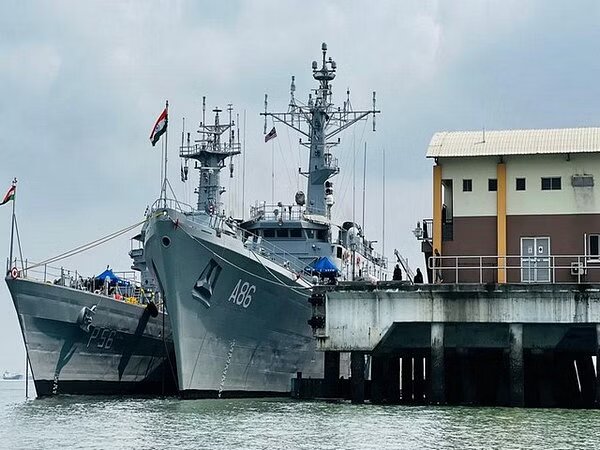India is getting more and more excited for the second Indian Navy’s Naval Innovation and Indigenization Seminar, Swavlamban, which will take place in New Delhi on October 4th and 5th. Autonomous Weaponized Boat Swarms for the Indian Navy and the first autonomous underwater vehicle (AUV) are just a few of the ground-breaking new technologies that will be shown off at this event.
The Indian Navy and Sagar Defence Engineering Pvt. Ltd. have recently formed a major agreement to help develop Autonomous Weaponized Boat Swarms. Also, Sagar Defence Engineering Pvt. Ltd. has stated that an Acceptance of Necessity (AoN) has been issued for the purchase of 30 AUVs. This is a big step toward improving the Indian Navy’s abilities.
About Sagar Defence Engineering Pvt Ltd
One of the winners in the Innovations for Defence Excellence (iDEX) DISC 7 program was Sagar Defence Engineering Pvt. Ltd. They earned the award under the SPRINT (Supporting Pole-vaulting In R&D through Innovations for Defence Excellence) scheme. The 50th contract under the “SPRINT” scheme was just signed by Sagar Defence Engineering Pvt. Ltd and the Indian Navy. As part of the Azadi ka Amrit Mahotsav celebrations, this scheme aims to develop 75 new technologies for the Indian Navy.
SPRINT initiative
Prime Minister Narendra Modi and Defense Minister Rajnath Singh launched this project. Its goal is to encourage new ideas and technological progress in the Defense and Aerospace Sector. According to the Indian Defense Minister, he is confident that the SPRINT plan will make the Indian military stronger and better able to handle itself. This change is likely to make the country’s security system stronger as a whole.
It works with many groups, like Micro, Small, and Medium-Sized Businesses (MSMEs), start-ups, and individual innovators, to develop specific technologies. The Indian Navy and Sagar Defence Engineering Pvt. Ltd. recently signed a deal to build Autonomous Weaponized Boat Swarms. This is the 50th contract given out under the “SPRINT” program, which aims to make 75 new technologies for the Indian Navy as part of the Azadi ka Amrit Mahotsav celebrations.
The defense minister is hopeful that putting the SPRINT plan into action will give the Indian industry a boost and make it stronger and more self-sufficient. Along with this, it will help make the country’s defense system stronger.
In the past few years, India has worked hard to create a good setting for its own industries. This has helped local businesses grow and met the security needs of friendly countries. This fits with the goal of “Make in India, Make for the World,” which promotes independence and working together around the world.
More about Autonomous Weaponized Boat Swarms
Self-Driving Weaponized Boat Swarms are about to change the way naval actions are done, which will improve India’s maritime defense. People think that these swarms will give us new tactical benefits and make our country safer.
- Versatile Weapons and Sensors: Autonomous Weaponized Boat Swarms have a wide range of weapons and state-of-the-art sensors that make them better at performing activities remotely or on their own.
- Integrated System: These swarm boats have an integrated system that lets them do a lot of different security and military tasks. Light-Speed Interdiction, Coastal Surveillance, Local Naval Defence, Constabulary Operations, C4ISR (Command, Control, Communications, Computers, Intelligence, Surveillance, and Reconnaissance), Medium-Sized Unmanned Surface Vessel, and Low-Intensity Maritime Operations (LIMO) are some of the things that fall under these missions.
- As part of NIIO and TDAC: The Naval Innovation and Indigenization Organization (NIIO) and the Technology Development Acceleration Cell (TDAC) are in charge of these ground-breaking projects. These groups are very important for moving forward with the development and use of these self-driving swarm boats, which improve India’s marine defenses.
What are Autonomous Underwater Vehicles (AUVs)
The Indian Navy has been given permission to buy 30 AUVs because they are needed. Because they can swarm, these AUVs give commanders big tactical benefits in both underwater and surface warfare.
Mine Counter Measures (MCM), anti-Submarine Warfare (ASW), hydrographic and oceanic data collection, as well as homeland security tasks like locating wrecks and protecting ports and coastlines, are just some of the tasks that these AUVs can be used for. Their ability to swarm lets them do more than one job while keeping their costs of capital and operations cheap. Their flexible design lets you change things like payloads and battery sizes, so they can be used in a range of environments and meet the needs of different users. Increasing India’s military power and protecting the country’s safety is now a big step closer.
